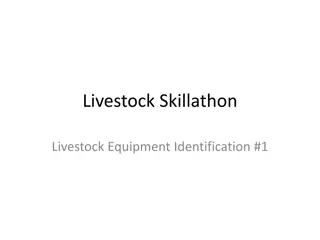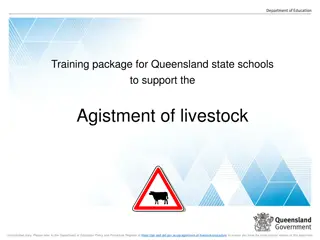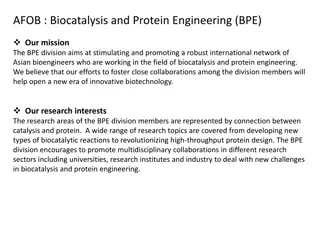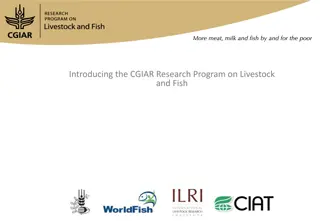Understanding Energy and Protein Requirements in Livestock
Assessing the energy and protein requirements in livestock is crucial to ensure optimal health and productivity. Dr. Pankaj Kumar Singh, Assistant Professor at Bihar Animal Sciences University, explains the significance of determining energy and protein needs for maintenance, metabolic processes, and overall well-being of animals. Proper assessment methods help prevent nutrient deficiencies and maintain equilibrium in livestock diets to avoid detrimental consequences such as fasting catabolism. Factors like basal metabolism and environmental conditions play a key role in measuring the energy needs of animals.
Download Presentation

Please find below an Image/Link to download the presentation.
The content on the website is provided AS IS for your information and personal use only. It may not be sold, licensed, or shared on other websites without obtaining consent from the author. Download presentation by click this link. If you encounter any issues during the download, it is possible that the publisher has removed the file from their server.
E N D
Presentation Transcript
Methods adopted for assessing energy and protein requirements in Livestock Dr. Pankaj Kumar Singh Assistant Professor, Deptt. of Animal Nutrition, Bihar Animal Sciences University, Patna E-mail: vetpank@gmail.com
Why to Determine Energy and Protein requirement of Livestock and Poultry?
ENERGY REQUIRMENTS FOR MAINTENANCE Maintenance requirement The maintenance requirement of a nutrient can be defined as the quantity which must be supplied in the diet so that the animal experiences neither net gain nor net loss of the nutrient. An animal is in a state of maintenance when the amount of nutrients in the feed will maintain the animal in equilibrium i.e., body composition remains constant and is not growing, not working or not giving any product as milk or mutton or egg. This minimum demand of feed is the maintenance requirement.
ENERGY REQUIRMENTS FOR MAINTENANCE If this need is not met, the animals are forced to draw upon their body reserves to meet their nutrient requirements for maintenance, commonly revealed by a loss in weight and other undesirable consequences. The destruction of body tissue is referred to as fasting catabolism.
ENERGY REQUIRMENTS FOR MAINTENANCE Fasting catabolism In the absence of feed, the nutrients required to support the activities essential to life (viz,respiration, circulation, maintenance of muscular tonus, manufacture of internal secretions, etc. ) come from the breakdown of body tissue itself. This destruction of body tissue is referred to as the fasting catabolism and it can be measured in terms of the waste products eliminated through the various paths of excretion. Most of the tissue breakdown occurs to meet the demand of the fasting organism for energy for its vital processes.
BASALAND FASTING METABOLISM Basal Metabolism refer to the heat production of an animal resting in a thermally neutral environment (25oC) and in a post-absorptive state (that is after the digestion and absorption of the last food ingested has stopped).
Conditions essential for measuring BMR : 1) Good nutritive condition: Previous diet of the animal has been adequate. Poor state of previous nutrition tends to decrease basal heat production. 2) Environmental temperature: Temp.25oC (thermoneutral environment). 3) Rest: Minimum muscular activity. Very difficult for animals other than man. BMR is 10-15% higher when animals are standing than that of lying down 4) Post-absorptive state: State when the process or digestion or absorption disappears. Overnight starvation in case of human, Ruminants about 3-4 days Last two conditions cannot be fulfilled for ruminant animals, hence the term resting metabolism is used in place of basal metabolism. Resting metabolism denotes the heat eliminated when animal is lying at rest
Fasting metabolism/ Basal metabolism Heat production or basal metabolism rate varies with body size. Rubner developed the concept of surface area law Heat given off by is directly proportional to their body surface. B.M (Kcal) = 70 W 0.75 Kg The coefficient 70 is an average value for the Kcal of basal heat produced per unit of metabolic size of adult mammals. .
Methods to determine the energy required for maintenance of animals: 1) Measuring basal or fasting metabolic rate 2) Short and long term trials with mature, non producing animals fed at the maintenance level (if the energy content of their food is known). 3) Feeding trials with different levels of feed intakes and by extrapolation of intake of feed towards zero level of production.
Methods adopted to estimate energy requirements for maintenance Fasting metabolism as a basis for estimating maintenance requirement: Energy expended for maintenance of an animal is converted into heat and leaves the body. Dry non-producing, mature animals are fasted, kept in a thermoneutral environment and their heat production determined (fasting catabolism). This gives an estimate about the minimum quantity of net nergy which must be supplied to the animal to keep it in energy equilibrium. This can be estimated by both direct and indirect
Protein Requirements for Maintenance Loss of protein continuously occurs through wear and tear of body tissue, for renewal of hairs, nails, feathers, hooves etc., which represents the amount of protein required for maintenance. The losses of body protein in the animal when kept on a protein free ration occurs through urine and faeces in negligible amount, through shedding of hairs, loss of nail, skin etc. The loss, which occurs through urine, is known as EUN or endogenous urinary nitrogen loss and loss, which occurs through faeces, is called MFN or Metabolic faecal nitrogen loss.
Endogenous Nitrogen metabolism(EUN): Loss of nitrogen is due to the catabolism incidental to maintenance of the vital tissues of the body, which can be measured at the minimum urinary excretion on a nitrogen free otherwise adequate (particularly energy adequacy) diet. EUN is a function of body size. Mammals excrete 2 mg of EUN/Kcal of basal metabolism or 140 mg N/kg0.75/day. EUN is highest in young animals EUN is lowest during hibernation. EUN of Indian cattle 0.2g/kg BW
Metabolic faecal nitrogen (MFN or FNm): MFN consists of spent digestive enzymes, abraded mucosa and bacterial nitrogen. MFN is proportional to feed intake. The MFN values determined in Indian cattle were 0.35 g/100 g DMI and in buffaloes 0.34 g/100 g DM intake. Endogenous urinary nitrogen and metabolic faecal nitrogen put together has come to 350 mg N/kg metabolic body size per day in ruminants. It is two to three times as great as in non-ruminants.
Methods adopted to estimate protein requirement for maintenance 1. Nitrogen balance method Various rations containing different levels of protein are fed to the various groups of non producing adult and healthy animals. The rations are otherwise adequate in energy, minerals and vitamins required by the animals. Nitrogen balance is determined in the experimental animals. The minimum protein intake at which nitrogen equilibrium is achieved is the maintenance requirement.
Methods adopted to estimate protein requirement for maintenance 2. Feeding trial method Long term feeding trials are conducted with non producing adult, healthy animals which are kept on different levels of protein with adequate intake of energy, minerals and vitamins. The level of protein at which the animal maintains its body weight without loss or gain over an extended period is considered the maintenance requirement of protein.
Methods adopted to estimate protein requirement for maintenance 3. Factorial method EUN and MFN are estimated to assess protein requirement. Dermal losses of hair and scuff (2.2g N/d) are also included. The net requirement, however only covered replacing these losses and the efficiency with which the absorbed protein is utilized (BV value) also must be considered. BV values of 70% for cattle and 65% for sheep.
ESTIMATION OF ENERGY REQUIREMENT FOR GROWTHAND FATTENING Growth is the increase in weight and or size that occurs over time Energy requirement for growth and fattening can be obtained by 1) Factorial calculations 2) Feeding trials Factorial calculations The principle of energy requirement for growth is that the energy of the tissue formed is determined first and the value of basal metabolism increased by an activity factor is added to it. Thus the requirement of energy is determined at any given period by the expected rate of gain and the average body weight during the period in question. Data from the slaughter experiment in respect of the fat and protein provides the figure for computing the calories for expected rate of gain while the body weight data provide the basis for arriving at the required energy for basal metabolism. An activity increment over the energy required for basal metabolism has to be considered. The data of basal metabolism and activity factor is to cover the maintenance requirement.
ESTIMATION OF Protein REQUIREMENT FOR GROWTH 1. Nitrogen balance studies It is an exact measure of actual requirement of protein. Calves are raised on equal amounts of dry matter and on isocaloric rations which contain different levels of protein and the minimum intake of protein which provides maximum retention is taken as the estimate of requirement. Disadvantages It is a short-term measurement carried out under closely controlled conditions and thus question always arises as to how accurately the results apply to the long-term feeding.
ESTIMATION OF Protein REQUIREMENT FOR GROWTH 2. Feeding trials The rations containing different levels of protein are fed to determine the minimum level required to give the maximum rate of growth. The nature of growth thus obtained may be further tested by slaughter tests for assessing the integrity of the nitrogenous tissues.
ESTIMATION OF Protein REQUIREMENT FOR GROWTH 3. Factorial method The amount of protein required for maintenance is determined first. The value thus obtained is added to the amount of protein required for growth (or say gain in weight) plus losses in metabolism. The maintenance needs can be determined directly on the basis of endogenous urinary nitrogen or calculated from the basal energy metabolism and later corrected for metabolic faecal nitrogen losses. The amount required for the growth tissue formed can be estimated from the slaughter data.























